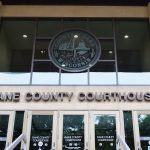Racial Disparities Found in Safer-At-Home Arrests
The vast majority of those cited for violations of the order were Black.

Most of the safer-at-home arrests occurred on the city’s North Side. A spokeswoman for the police department says: “The Milwaukee Police Department took great pains to ensure that our members educated the public prior to taking enforcement action.” File photo by Edgar Mendez/NNS.
African Americans make up the majority of residents arrested on charges of violating Milwaukee’s safer-at-home order, according to data obtained from the Milwaukee Police Department through a public records request.
Of the 177 individuals arrested from March 27 to May 12, 138 were African American (78 percent), and 21 were Hispanic (12 percent), according to MPD data. Only 6 percent of those arrested were white.
The safer-at-home measure began being enforced in Milwaukee and other cities in Wisconsin as fears grew over the spread of the coronavirus.
MPD spokeswoman Sgt. Sheronda Grant said 173 people were arrested for committing other crimes while violating the safer-at-home order.
The other four arrests involved a business owner who refused to abide by the order; two individuals caught fleeing from police; and another person involved in a fistfight that resulted in a nonfatal shooting, she said.
When asked about racial disparities in arrests, Grant told NNS: “The police department did not target anyone for being outside their places of residence or business.
“The Milwaukee Police Department took great pains to ensure that our members educated the public prior to taking enforcement action.”
But leaders from the ACLU of Wisconsin say the arrests point to a troubling pattern by the Milwaukee Police Department.
“We’re concerned that these arrests reflect the disparate treatment at the hands of Milwaukee police that the community has long experienced,” the ACLU of Wisconsin said in an email to NNS.
The organization has consistently criticized the MPD and the Fire and Police Commission for their efforts to comply with the terms of a $3.4 million settlement in the ACLU’s stop-and-frisk lawsuit against the city.
The class-action lawsuit, filed in February 2017, was brought by the American Civil Liberties Union, the ACLU of Wisconsin and the law firm Covington and Burling., representing Charles Collins and eight other Milwaukee residents.
Collins, a military veteran and longtime Milwaukee resident in his late 60s, was pulled over by MPD officers while driving home with his wife after visiting their son in 2014. Like the other plaintiffs, he broke no laws and was never charged.
Mayor Tom Barrett said Wednesday he was troubled by the disparities in arrests, especially considering ongoing racial equity issues.
“The intention has never been to penalize or punish people, but find what is the most effective way for people to take actions to protect their best health interests,” said Barrett, adding that African American and Latino populations in the city have been hit hardest by COVID-19.
More arrests on North Side
The data also reveals that most of the arrests occurred on the city’s North Side. Of those arrests, 46, or 26 percent of the total, occurred in the 53206 ZIP code, an area known for its concentrated poverty, extreme joblessness, levels of mass incarceration and declining incomes for those who are employed.
Aside from those ZIP code areas, only 53204 on the near South Side had more than 15 arrests. In addition, 17 minors were arrested for violating the order. All of the minors were African American or Hispanic, the data shows.
Grant said 53206 experienced the most calls for police service for all ZIP codes during the time the order was in place, while 53209 had the fifth-most calls.
“We are obligated to respond to calls for service regardless of the ZIP code from which the calls originate,” she said.
This story was originally published by Milwaukee Neighborhood News Service, where you can find other stories reporting on fifteen city neighborhoods in Milwaukee.
More about the Coronavirus Pandemic
- Governors Tony Evers, JB Pritzker, Tim Walz, and Gretchen Whitmer Issue a Joint Statement Concerning Reports that Donald Trump Gave Russian Dictator Putin American COVID-19 Supplies - Gov. Tony Evers - Oct 11th, 2024
- MHD Release: Milwaukee Health Department Launches COVID-19 Wastewater Testing Dashboard - City of Milwaukee Health Department - Jan 23rd, 2024
- Milwaukee County Announces New Policies Related to COVID-19 Pandemic - County Executive David Crowley - May 9th, 2023
- DHS Details End of Emergency COVID-19 Response - Wisconsin Department of Health Services - Apr 26th, 2023
- Milwaukee Health Department Announces Upcoming Changes to COVID-19 Services - City of Milwaukee Health Department - Mar 17th, 2023
- Fitzgerald Applauds Passage of COVID-19 Origin Act - U.S. Rep. Scott Fitzgerald - Mar 10th, 2023
- DHS Expands Free COVID-19 Testing Program - Wisconsin Department of Health Services - Feb 10th, 2023
- MKE County: COVID-19 Hospitalizations Rising - Graham Kilmer - Jan 16th, 2023
- Not Enough Getting Bivalent Booster Shots, State Health Officials Warn - Gaby Vinick - Dec 26th, 2022
- Nearly All Wisconsinites Age 6 Months and Older Now Eligible for Updated COVID-19 Vaccine - Wisconsin Department of Health Services - Dec 15th, 2022
Read more about Coronavirus Pandemic here






















